

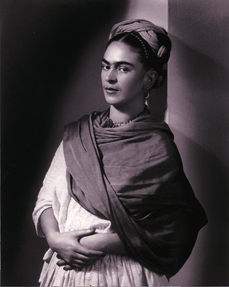
Portrait by Nickolas Muray
Frida Kahlo, was born on July 6, 1907 in the
Frida claimed to be born on 1910, the year of the outbreak of the Mexican revolution, because she wanted her life to begin together with the modern
She did not originally plan to become an artist. At 15 Kahlo entered the premedical program at the
Her life was marked by physical suffering, starting with polio contracted at the age of five and progressively worsening through her life-dominating event, the bus accident when she was 18. She underwent approximately 30 surgical operations and numerous painful treatments including an array of corsets and mechanical "stretching" systems. Many of her works were painted lying in bed. To add to her trauma, she was never able to have children as a complication of her injuries.
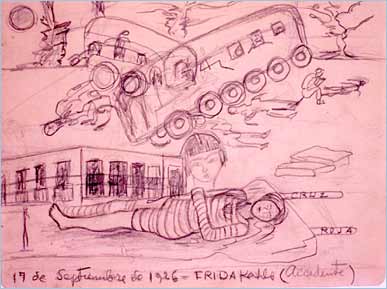
The Accident - 1926
One year after the bus collision, she sketched The Accident, in the style of traditional Mexican ex-voto paintings. As religious works of art, ex-voto paintings, usually executed on tin sheets, portray scenes of miraculous heavenly interventions. The miracle in this sketch, Frida did not die. Describing events with both pictures and words shows another signature of the ex-voto style. Most of Frida's paintings would incorporate elements of the ex-voto style. (http://www.pbs.org/weta/fridakahlo/worksofart/accident.html)
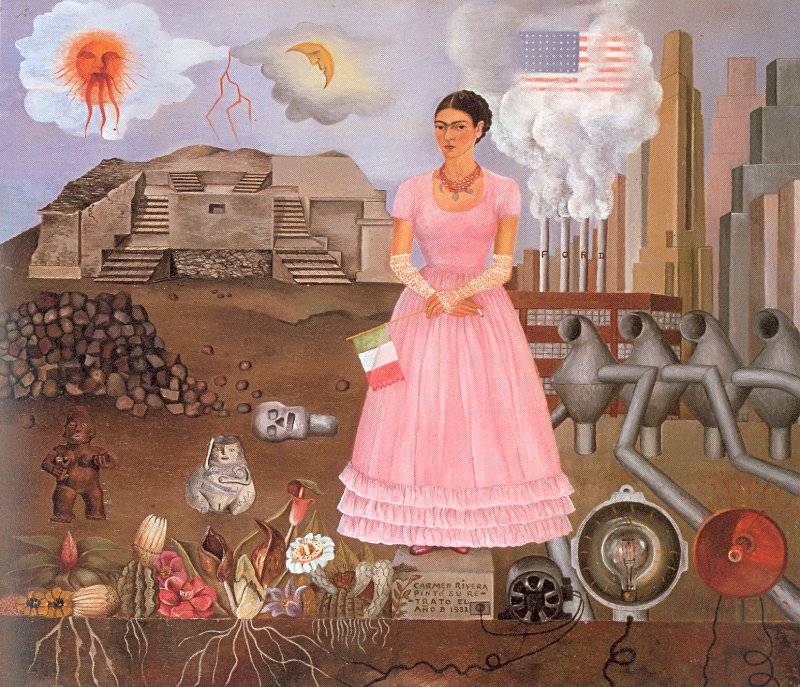
Self-Portrait on the Borderline between Mexico and the United States - 1932 - http://cgfa.sunsite.dk/kahlo/p-kahlo28.htm
Drawing on her personal experiences (her troubled marriage, her painful miscarriages, her numerous operations), her works are often shocking in their stark portrayal of pain. Fifty-five of her 143 paintings are self-portraits, often incorporating symbolic portrayal of her physical and psychological wounds.
Another thematic element in her work developed from her deeply felt influence of the indigenous Mexican culture, which surfaced in her paintings' bright colors, dramatic symbolism, and unapologetic rendering of often harsh and gory content.
Although Kahlo's work is sometimes classified as surrealist, and she did exhibit several times with European surrealists, she never considered herself a surrealist. Her preoccupation with female themes and the figurative candor with which she expressed them made her something of a feminist cult figure in the last decades of the 20th century. (http://en.wikipedia.org/wiki/Frida_Kahlo)
Kahlo preferred dressing in native Mexican costume and paid great attention to her hair and make-up even when gravely ill. The numerous self-portraits she created range in mood from violent (i.e. showing herself as a deer shot through with arrows or a woman ripped open from neck to navel and covered with nails), to heart-rending (showing herself naked and bleeding profusely from complications of childbirth), to more serene images such as the Self-Portrait with Monkey.
Kahlo's imagery reflects a preoccupation with the exploration of love and its connection to pain in her life. She had many lovers, both male and female, and was married twice, first in 1929 and again in 1940, to the famous Mexican muralist Diego Rivera, whom she loved obsessively. The small, slender Kahlo was a stark contrast to the portly Rivera. Her father remarked, "It was like the marriage between an elephant and a dove." Their stormy relationship inspired many of her paintings. As her biographer, Hayden Herrera, noted, "Every time Diego left her, there's another painting with tears or gashes." In Kahlo's own words, Rivera showed her "the revolutionary sense of life and the true sense of color."
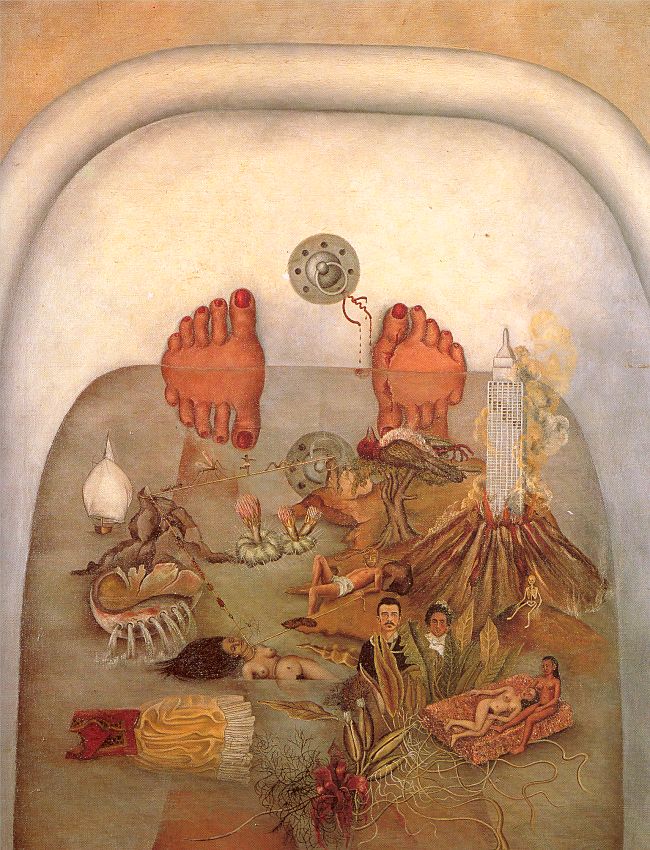
What I Saw in the Water (What the Water Gave Me) - 1938 - http://cgfa.sunsite.dk/kahlo/p-kahlo11.htm

Self-Portrait with Monkey - 1938
In October 1938, Frida staged her first one-woman exhibition at the Levy Gallery in
In Self-Portrait with Monkey, Kahlo emphasized her signature icon, her joined eyebrows. She chose a monkey as her companion because she admired its childlike and playful nature. The apparently naïve (unschooled) drawing, bright and bizarre colors, and dramatic and fantastical images reflect her inspiration in native Mexican art. (http://www.pbs.org/weta/fridakahlo/worksofart/index.html)
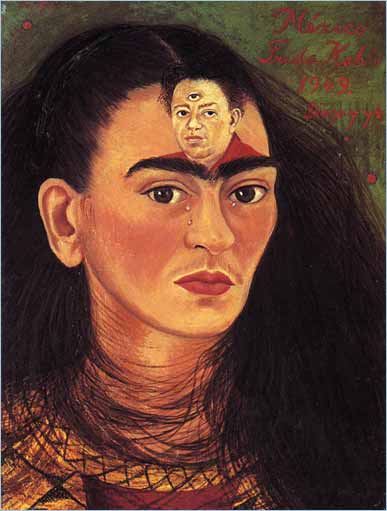
Diego and I - 1949
She was his chicuita ("little one") and he was her "frog prince," but the path of love was not a smooth one for Frida and Diego. Almost from the moment of their marriage in 1929, there were problems. But 1949 was a particularly low point in their relationship. Rumors circulated that Diego intended to marry the film star Maria Felix, with whom he was having an affair. Although nothing came of the affair and Diego remained with Frida, she was hurt. The self-portrait Diego and I came out of this experience. (http://www.pbs.org/weta/fridakahlo/worksofart/diegoandi.html)
Active Communist sympathizers, Kahlo and Rivera befriended Leon Trotsky as he sought political asylum from Joseph Stalin´s regime in The Soviet Union. The great Russian revolutionary had been expelled from the U.S.S.R. by Stalin in 1929 and sentenced to death, in absentia, by a Soviet court in 1937. After nine years of exile, in January 1937 Trotsky and his wife found asylum in
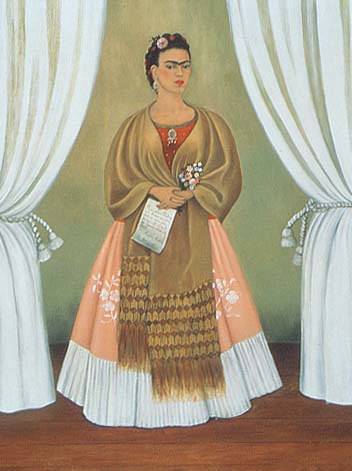
Self-Portrait Dedicated to Leon Trotsky - 1937
This self-portrait shows the same Frida Kahlo seen in numerous photographs: intense, with broad, expressive eyebrows and a fondness for traditional Mexican garb. However, it omits the overt symbolism and sometimes-harrowing depictions of her medical history featured in many other self-portraits.Instead, the artist displays herself standing on a stagelike wooden floor between curtains dramatically tied back with heavy cords. Kahlo's hair is braided and adorned with flowers; she wears a long embroidered dress, a rebozo (Mexican shawl), and gold jewelry, calling attention to her carefully manicured hands, which hold a small bouquet and a sheet of paper. The fact that her feet are hidden makes Kahlo appear to float, and the overall composition recalls retablos, the small Mexican religious images painted on tin that Kahlo avidly collected. The paper, with its inscription, signature, and date, is a surprisingly old-fashioned touch. In it, Kahlo dedicates the self-portrait to Leon Trotsky, "with all [her] love." Kahlo presented this painting to the Russian revolutionary leader as a gift, presumably a memento of the brief love affair they had shortly after his arrival in Mexico.The great Russian revolutionary had been expelled from the U.S.S.R. by Stalin in 1929 and sentenced to death, in absentia, by a Soviet court in 1937. After nine years of exile, in January 1937 Trotsky and his wife found asylum in Mexico, thanks to Rivera's help. They lived in Kahlo's house for two years, before Trotsky was assassinated by a Stalinist agent. (National Museum of Women in the Arts - http://www.nmwa.org/collection/detail.asp?WorkID=1432)
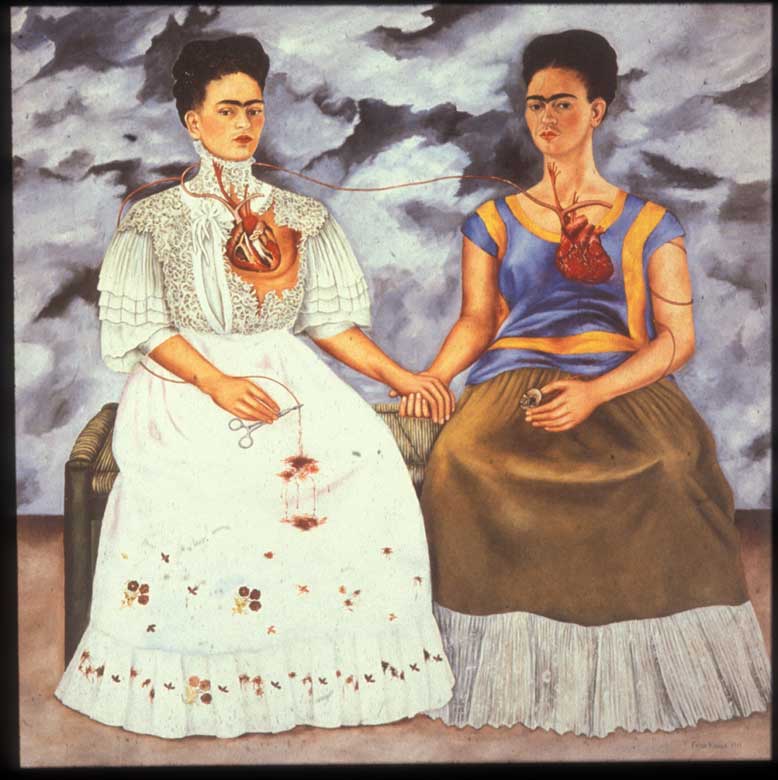
The Two Fridas - 1939 - http://academic.reed.edu/spanish/courses/Spanish-210/Frida/Frida-TheTwoFridas.html
Painted in 1939 at the time of her divorce from Diego, The Two Fridas is believed to be an expression of Frida's feelings at the time. This double self-portrait was the first large-scale work painted by Frida. (http://www.pbs.org/weta/fridakahlo/worksofart/index.html)
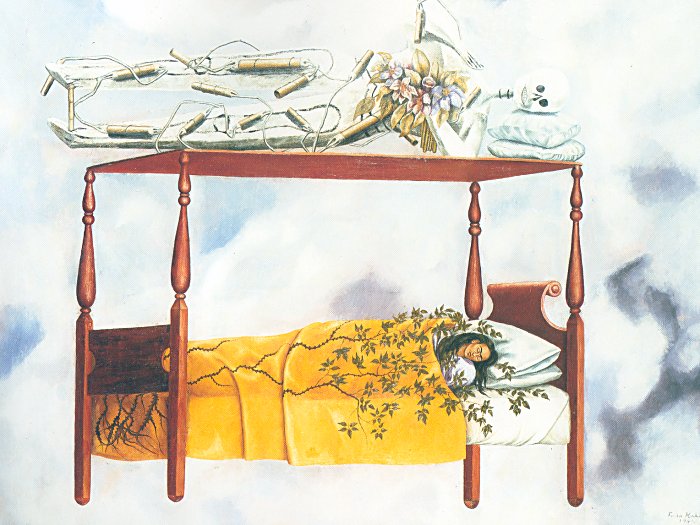
The Dream - 1940 - http://cgfa.sunsite.dk/kahlo/p-kahlo18.htm
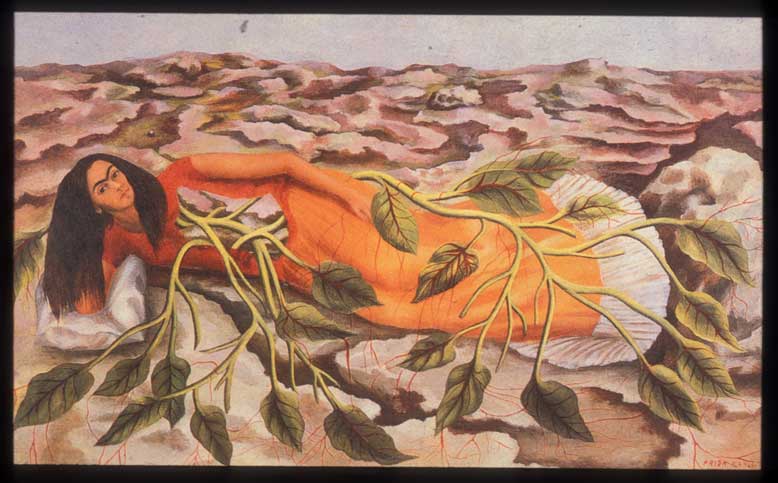
Roots - 1943 - http://academic.reed.edu/spanish/courses/Spanish-210/Frida/Frida-Roots.jpg
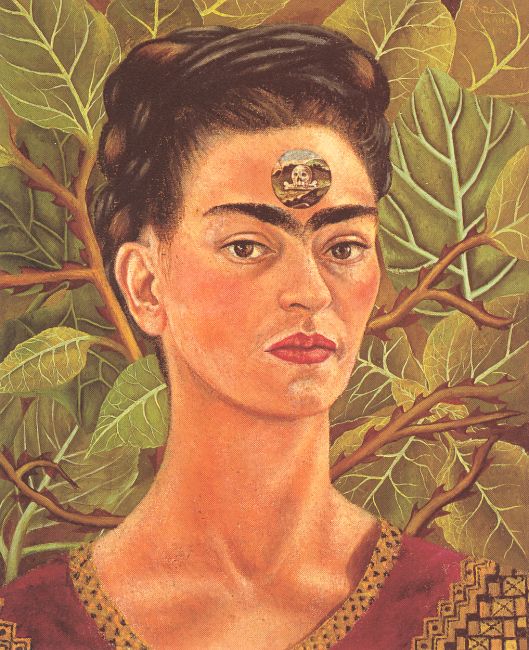
Thinking about Death - 1943 - http://cgfa.sunsite.dk/kahlo/p-kahlo26.htm
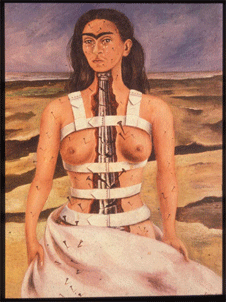
Broken Column - 1944 - http://academic.reed.edu/spanish/courses/Spanish-210/Frida/Frida-BrokenColumn.jpg
Kahlo was a famous personality in her time, and lived a life full of drama and passion right to the end. When her first major exhibition finally opened in
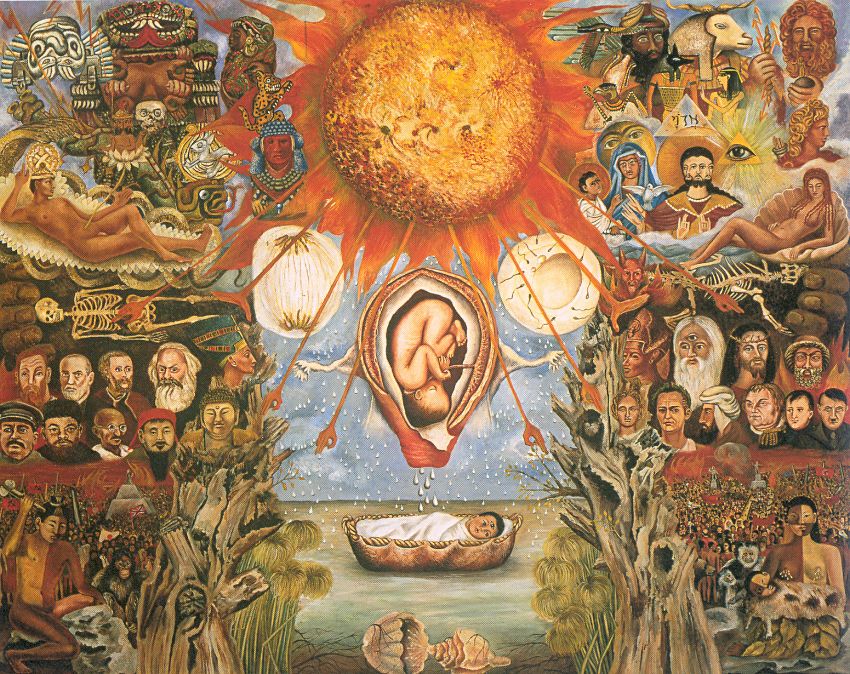
Moses (Nucleus of Creation) - 1945 - http://cgfa.sunsite.dk/kahlo/p-kahlo23.htm
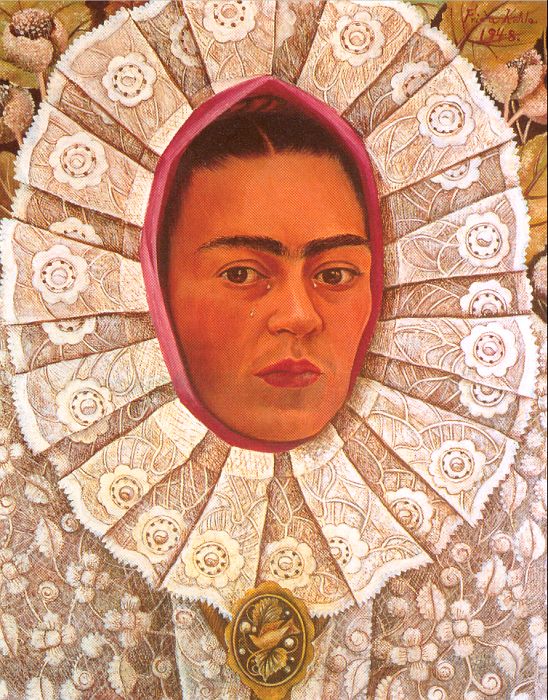
Self-Portrait - 1948 - http://cgfa.sunsite.dk/kahlo/p-kahlo9.htm
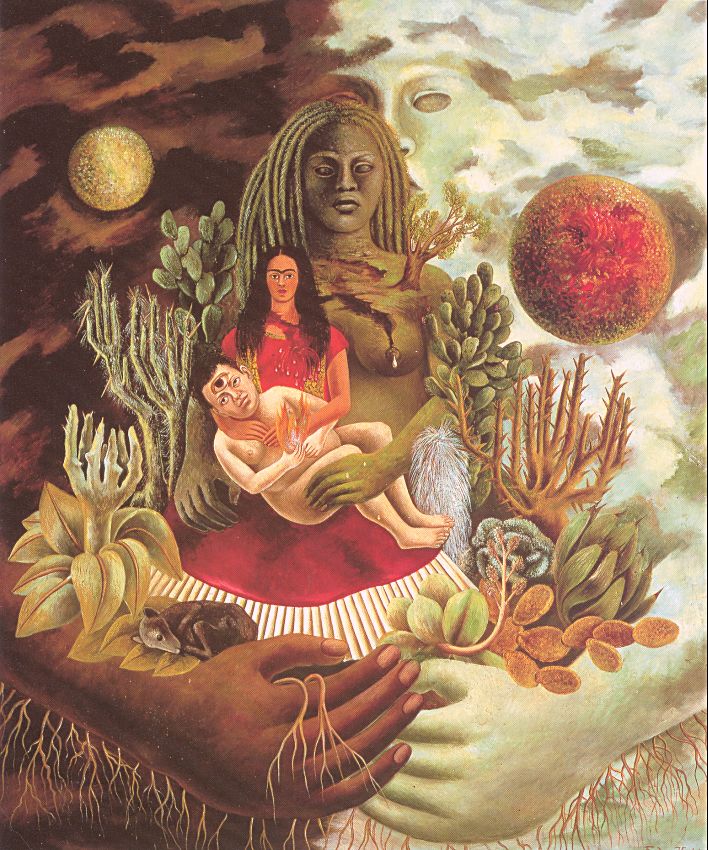
The Love Embrace of the Universe, the Earth, Myself, Diego and Señor Xólotl
1949 - http://cgfa.sunsite.dk/kahlo/p-kahlo25.htm
Wednesday, July 14, 1954
Frida Kahlo, Artist, Diego Rivera's Wife
She also was a painter and also had been active in leftist causes. She made her last public appearance in a wheel chair at a meeting here in support of the new ousted regime of Communist-backed President Jacobo Arbenz Guzman of
Frida Kahlo began painting in 1926 while obliged to lie in bed during convalescence from injuries suffered in a bus accident. Not long afterward she showed her work to Diego Rivera, who advised, "go on painting." They were married in 1929, began living apart in 1939, were reunited in 1941.
Usually classed as a surrealist, the artist had no special explanation for her methods. She said only: "I put on the canvas whatever comes into my mind." She gave one-woman shows in
Some of her pictures shocked beholders. One showed her with her hands cut off, a huge bleeding heart on the ground nearby, and on either side of her an empty dress. This was supposed to reveal how she felt when her husband went off alone on a trip. Another self-portrait presented the artist as a wounded deer, still carrying the shafts of nine arrows.
|
|
Melissa and I would like to |